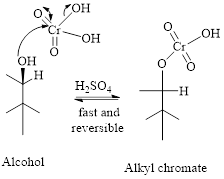
Concept explainers
(a)
Interpretation:
The product formed in the reaction of 1-Hexanol with chromic acid has to be drawn.
Concept Introduction:
Oxidation of alcohols: Oxidation of primary alcohol gives an
Chromic acid Oxidation of an Alcohol:
Step 1: Reaction of alcohol and chromic acid gives an alkyl chromate. No change in oxidation state of both Carbon and Chromium.

Step 2: Take a proton away and simultaneously break bonds to give stable molecules or ions. Reaction of the alkyl chromate with a base (here water molecule) results in cleavage of a

(b)
Interpretation:
The product formed in the reaction of 2-Hexanol with chromic acid has to be drawn.
Concept Introduction:
Oxidation of alcohols: Oxidation of primary alcohol gives an aldehyde or a carboxylic acid, depending on experimental conditions.
Chromic acid Oxidation of an Alcohol:
Step 1: Reaction of alcohol and chromic acid gives an alkyl chromate. No change in oxidation state of both Carbon and Chromium.

Step 2: Take a proton away and simultaneously break bonds to give stable molecules or ions. Reaction of the alkyl chromate with a base (here water molecule) results in cleavage of a

(c)
Interpretation:
The product formed in the reaction of Cyclohexanol with chromic acid has to be drawn.
Concept Introduction:
Oxidation of alcohols: Oxidation of primary alcohol gives an aldehyde or a carboxylic acid, depending on experimental conditions.
Chromic acid Oxidation of an Alcohol:
Step 1: Reaction of alcohol and chromic acid gives an alkyl chromate. No change in oxidation state of both Carbon and Chromium.

Step 2: Take a proton away and simultaneously break bonds to give stable molecules or ions. Reaction of the alkyl chromate with a base (here water molecule) results in cleavage of a

Trending nowThis is a popular solution!

Chapter 10 Solutions
Organic Chemistry
- Would the following organic synthesis occur in one step? Add any missing products, required catalysts, inorganic reagents, and other important conditions. Please include a detailed explanation and drawings showing how the reaction may occur in one step.arrow_forward(a) Sketch the 'H NMR of the following chemical including the approximate chemical shifts, the multiplicity (splitting) of all signals and the integration (b) How many signals would you expect in the 13C NMR? CH3arrow_forwardDraw the Show the major and minor product(s) for the following reaction mechanisms for both reactions and show all resonance structures for any Explain why the major product is favoured? intermediates H-Brarrow_forward
- 3. Draw ALL THE POSSBILE PRODUCTS AND THE MECHANISMS WITH ALL RESONANCE STRUCTURES. Explain using the resonance structures why the major product(s) are formed over the minor product(s). H₂SO4, HONO CHarrow_forward7. Provide the product(s), starting material(s) and/or condition(s) required for the No mechanisms required. below reaction HO + H-I CI FO Br2, FeBr3 O I-Oarrow_forward6. Design the most efficient synthesis of the following product starting from phenot Provide the reaction conditions for each step (more than one step is required) and explain the selectivity of each reaction. NO MECHANISMS ARE REQUIRED. OH step(s) CIarrow_forward
- What is the skeletal structure of the product of the following organic reaction?arrow_forwardIf a reaction occurs, what would be the major products? Please include a detailed explanation as well as a drawing showing how the reaction occurs and what the final product is.arrow_forwardWhat is the major organic product of the following nucleophilic acyl substitution reaction of an acid chloride below?arrow_forward
 Chemistry for Today: General, Organic, and Bioche...ChemistryISBN:9781305960060Author:Spencer L. Seager, Michael R. Slabaugh, Maren S. HansenPublisher:Cengage Learning
Chemistry for Today: General, Organic, and Bioche...ChemistryISBN:9781305960060Author:Spencer L. Seager, Michael R. Slabaugh, Maren S. HansenPublisher:Cengage Learning Organic Chemistry: A Guided InquiryChemistryISBN:9780618974122Author:Andrei StraumanisPublisher:Cengage Learning
Organic Chemistry: A Guided InquiryChemistryISBN:9780618974122Author:Andrei StraumanisPublisher:Cengage Learning

